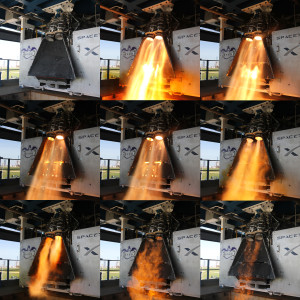 The propulsion system SpaceX would use to power its Crew Dragon out of danger has been test-fired 27 times as the company refines the design for the demands of operational missions carrying astronauts to the International Space Station for NASA’s Commercial Crew Program. SpaceX evaluated the system utilizing various thrust cycles on a test stand at its McGregor, Texas, rocket development facility.
The propulsion system SpaceX would use to power its Crew Dragon out of danger has been test-fired 27 times as the company refines the design for the demands of operational missions carrying astronauts to the International Space Station for NASA’s Commercial Crew Program. SpaceX evaluated the system utilizing various thrust cycles on a test stand at its McGregor, Texas, rocket development facility.
Named SuperDracos, the engines are arranged in four pairs – SpaceX calls them ‘jetpacks’ – integrated around the outside of the Crew Dragon spacecraft. Firing all at once, the eight engines produce 120,000 pounds of thrust – enough power to accelerate a Crew Dragon from zero to 100 mph in 1.2 seconds. In the unlikely event of an emergency, that power means the ability to lift the crew a safe distance off the launch pad or far away from a booster failing on the way to orbit. That capability was demonstrated earlier this year in a pad abort test that confirmed the SuperDraco design in a flight-like condition.
A normal launch of the Crew Dragon atop a Falcon 9 rocket would not offer the SuperDracos anything to do during the mission since their only responsibility is to fire in an emergency to rescue the crew onboard. Eventually, SpaceX plans to use the SuperDracos in the place of a parachute during landing.
They use hypergolic propellants common in spacecraft thruster systems because the propellants ignite as soon as they contact each other. The engines are noteworthy for a number of reasons, including that they are built using 3-D printing methods instead of machining them from larger pieces.
After the development cycle, the propulsion system and SuperDracos will continue evaluations at the company’s test stand to qualify them for use on operational missions.
SpaceX and Boeing are developing a new generation of American-made, human-rated transportation systems capable of taking astronauts to the space station in partnership with NASA. The Crew Dragon and Boeing’s CST-100 Starliner will carry up to four NASA astronauts at a time, which ultimately adds another crew member to the space station and will allow twice as much time for astronauts to conduct research aboard the one-of-a-kind laboratory.
https://www.youtube.com/watch?v=https://www.youtube.com/watch?v=0zOzk0keqU8[/embedyt]

My question: you write “up to four astronauts”. I though the SpaceX Dragon could carry up to seven?
Up to 4 with cargo. Seven astronauts without cargo.
Love to follow the advancements of this forward thinking company. A little suspicious of the strut problem, though not of any intentional roll of Space X in it.
happy anniversary apollo 4
I have had a great interest in SpaceX for years and years. I want to see more! Congratulations on the success.
W.Pickens
Both Dragon and Starliner are designed for a maximum of 7 passengers. That was a requirement for the lifeboat function to evacuate all 7 members of the ISS if need be. However only 4 seats installed for normal operations. Presumably the additional 3 seats will be only temporarily installed in the docked capsule while at the ISS and removed before the capsule leaves with its normal compliment of passengers.